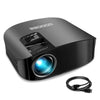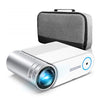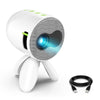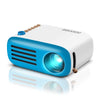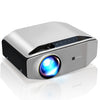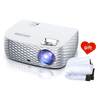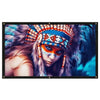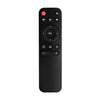
Things To Know When Buying A Projector
Are you a fan of movies? Do you crave a cinematic experience at home? What if you can create a theatre in your house? That’s right! No more waiting in queues to get a movie ticket. You can buy your very own projector.
With its widescreen and high picture quality, a projector is more affordable than a television. Moreover, it is compact and portable. Set it up at any corner in your house, grab some popcorn, and enjoy!

Choosing a projector from an endless list of options can be tedious. You may find yourself confused and end up getting nothing at all. This is because you did not know what to look for in a projector. You must have a lot of questions.
How to know which projector is the perfect model for your house? How to choose the perfect home theater projector? Well, it’s time to find out!
There are certain things to buying a projector. It is essential to know what you are looking for exactly. This article will answer all your questions. With this, choosing a projector will be just as easy as buying clothes at a shop.
Table of Contents:
- Types of Projectors
- What do you need a projector for?
- What should be the size of your projector?
- What kind of light source does the projector use?
- What is the projector’s brightness?
- Aspect ratio and what it means
- Contrast ratio
- What is throw ratio?
- Projector resolution explained
- What is a projector’s connectivity?
Types of Projectors
There are different kinds of projectors available. It is essential to know the options before making a choice. There are two main types:
Digital light processing (DLP):
It creates an image on the screen of the projector. Pooling the the power of a color wheel, it lets the light go through towards the screen. They are reasonable.
Liquid crystal display (LCD):
LCD projectors allow light to pass through towards the screen by using three chips, enabling the image to appear on the screen. LCD projectors are further categorized into three variations, such as the following:
- Liquid crystal on silicon (LCOS)
- Digital image light amplifier (DILA)
- Silicon crystal reflective display (SXRD)
All these variations are majorly formed by the combination of DLP, LCD, and new technologies, and are usually more effective.
Once you are aware of these types, then these questions can be asked, mentioned below. There are plenty of things to know when buying a projector.
What do you need a projector for?
This is the most significant factor to consider even before checking the price of a projector. Knowing why you are buying the projector? For this, judge what you want for the following features:
-
Resolution
Imagine watching the Harry Potter films at the cinema? Do you love the jaw-dropping effects? If you want your projector to give a similar experience, make sure it has a high resolution like that of the Goodee YG601 Updated LCD Home Theater Projector. If you are looking forward to use the projector for business purpose, then you might not need a very high resolution.
-
Indoor or outdoor
It is essential to decide whether you want to set up the projector indoor or outdoor. Where will you place your projector? If you are planning to put it outdoor, then the one that has a high resolution would be great. The image will not be distorted due to the surrounding light, and the colors will be vibrant. If you are willing to place it indoor, then a standard resolution projector will do the job.
-
Noise
Make sure to choose a projector that does not make noise. You do not want to ruin your season with a non-stop whirring.
What should be the size of your projector?
It is an important concern when you look at projectors. If you buy a projector screen that doesn't fit in your room, then all your money and efforts will go to waste. You should always check this beforehand.
Projectors are available in different sizes. If you are going to place it in your hallway, you should go for a bigger projector. However, if you want a portable projector that you can carry around in different rooms, buy a small one. It not only makes it movable but also cheaper.
An excellent choice for a small projector is the Goodee YG220 Portable Mini Projector LED Video Projector.

What are the light sources does the projector use?
There are three types of light sources that a projector have. Such as the following:
LED:
- It can last for 20000 hours or even more.
- It is more convenient in comparison to a lamp projector.
- It has LED bulbs that render blue, red, and green colors.
- It has a longer lifespan.
- It does not overheat like lamp projectors.
- It is easy to start and stop.
Lamp:
- Mostly projectors that use lamp light sources do not last as long as the other two comparatively. It lasts for 3000 to 4000 hours.
- It usually heats after usage, which increases the requirement for cooling fans to drop the heat quickly with its speed.
- Getting overheat is a major problem after using the lamp projector for a long period of time. It might cause it to shut down thus decreasing its life span.
Laser:
- LASER stands for “light amplification by stimulating the emission of radiation.
- Laser projectors can stand up to 20000 hours or even more.
- It has almost the same features just like the LED projector, more of an updated version of it.
- It also has long life duration and it does not generate heat.
- However, laser projectors are expensive.
What is the projector's brightness?
It is imperative to find out the brightness of a projector because it greatly makes or breaks your experience. This is because it is a major factor affecting image quality.
Deciding how much brightness you need depends on where you are going to place your screen.
The surrounding light makes an impact. Is it your dark basement, or is it your bedroom?
It is recommended the brighter your projector is, the better it is. But it depends!
If you are using your projector in a dark room, then a low level of brightness will be okay.
It is important to figure out where you want to place your projector and then decide.
Aspect ratio and what it means
The aspect ratio is the shape of the video image that you are presenting on your projector. It depends on the resolution. Mostly, if the resolution varies, then the aspect ratio also varies.
Moreover, if the aspect ratio is high, then the size of your image will also be bigger. This will affect your selection of projector screen size. Most projectors are 16:9.
However, this might not be the case every time because sometimes resolutions vary, but aspect ratio remains the same. Thus, check how high is the aspect ratio before buying. This is how you can choose the perfect home theatre projector.
Contrast ratio
What to look for in a projector? Contrast ratio, it is another factor to consider. The contrast ratio will help you figure out the clarity of the display. It tells you the difference between the darkest and the brightest parts of the picture. For instance, if the contrast ratio is high, then the white parts get whiter and dark parts to become darker. It will make your display clearer.
However, if the brightness is high and the contrast ratio is relatively low, then it won't stand as a high-quality image. Every projector has different features. Some might offer you high contrast ratios but by reducing the angles of the view.
A high contrast ratio is when it has a ratio of 1,500: 1 or 2000:1.
Therefore, select a project with the most suitable contrast ratio, preferably the ones mentioned above.

What is the projector throw ratio?
Throw ratio is the distance between the screen and the projector. If you are aware of the distance and image width, then you will identify the throw ratio.
If your room is spacious and you are placing your device and screen far away, then you will need a high throw ratio. This will help you pick a projector that will be good for the space you are going to put it in.
If you are willing to buy a projector that has a high image-width, then the low throw ratio is recommended. The three types of projector throws are as follows:
Long-throw:
These projectors are used in large sized rooms that have a large space. There is a long- distance, and these show large images.
Short-throw:
It is suitable when the space is small. It shows large images when the distance between the projector screen and the projector is short. However, they are more expensive as compared to long-throw.
Ultra-throw:
These are the expensive ones as compared to others. Mostly the purpose for what people used it for was for commercial purpose. They produce high quality and big images, even when the distance is small. They can function in very confined spaces as well.
These are the things to know when buying a projector. It will help you guide make the right choice.
Projector resolution explained
Another aspect for quality! What comes to your mind when you hear projector resolution?
Basically, it is the number of pixels used in the pictures. The more the pixels are, the better will be the quality.
Resolution matters a lot. If you are using it for presentations purpose, then low resolutions would be enough, for instance, the SVGA is 800 x 600 pixels. If you are buying it for gaming purposes or for movies, then at least 1920 x 1080 pixels would be necessary. But generally, higher resolution is always better.
Now projectors are really advanced with at least 1024 x 768 resolution, a 4:3 aspect ratio format. There are different models and types of projectors with various features and resolutions.
If you want to buy a projector for using applications, then the higher resolution would be good ranged for 2600 x 1200 (UXGA) for 4:3 or 1920 x 1200 for 16:10 (WUXGA). If you want to make it a home theatre, then Full HD (1920 x 1080) would be recommended.
Note that for the best image projection, your projectors and your device’s native resolution should be the same.

What is the projector’s connectivity?
It is always best to buy the latest technology and have advanced features in your projector.
Therefore, you should check a projector’s connectivity capacity. It is whether the device connects with your mobile, laptop, or gadgets or not.
Now, HDMI connections are used mostly. It is a short form for "high definition multimedia interface." HDMI compliant device will transmit data of the video and audio to your projector.
This enables you to connect your projector to various devices easily.
VGA is also an older, for which doesn't provide high-quality videos in comparison to the connectivity through HDMI. On the other hand, its cable is very reasonable. So the decision is yours.
USB Connection:
USB connection is one of the basic types of connectivity. This will allow you to transfer videos, pictures through USB cable. Furthermore, there are USB connection ports that will enable you to make presentations using a USB drive. Then, there will be no need to use PC while giving presentations. It can handle a flash drive, which makes it handier while preparing and giving a presentation.
Wireless and Wired (LAN):
Some projectors have wireless and wired (LAN) connection. This will help you connect with your device through a network. There will be no such problems with handling too many wires. If you don't like wires bunching together, then this will be perfect for you. Your room will look neat also, just like your mother wants.
Your projector can be connected to many PCs. It is highly recommended for those people who use PowerPoint or display photos or graphics—the wireless projector ranges from a limit of a 30-foot line of sight.
WIFI Connection:
You should check whether it has Wi-Fi support or not. This will help you stream all your devices rather than plugging each in your projector.
You want to get a projector with multiple connection capabilities, such as the famous Goodee YG620 Newest LED projector with a variety of inputs, including HDMI, VGA, AV, and USB.
This is what you should look for in a projector beforehand. This will enable you to choose the perfect home theatre projector with most features and at a reasonable price that fits your budget.
Final Message:
Getting the most suitable projector is really important if you do not want to pay for maintenance and other issues later on. With this article, you can make the right choice at the right price with the features you were looking for. To make things easier, this projector buying guide will help you figure out all the questions that were coming in your mind. Furthermore, you can check out the Goodee projectors and projector screens, which offer a variety of options, all at the most affordable rates. Happy Shopping!


